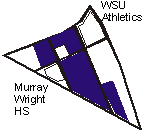University City - Woodbridge Historic Area Together
Title Page and Contents | Introduction
| History and Timeline | Community
Profile | Woodbridge Associational Map | Recommendations
| Appendix A | Appendix B | Appendix
C
II. History and Timeline
The future of Woodbridge depends on the joint effort of its residents
and local organizations. This future is connected to the past in that some
residents of Woodbridge have lived in the community since the early 1960s.
Some can even trace their roots back to the early 1900s. The 1980s and
1990s brought many new faces to the Woodbridge community, including professionals
drawn by the historical value of the neighborhood's homes and the convenience
of city living. This influx of new people has been a double-edged sword
in some ways. It has promoted the rehabilitation of the historic community,
but with the renewed interest some long-term residents fear that they may
be displaced through gentrification; a process where property values increase
to the point that older residents can no longer afford to live in the area.
The history of Woodbridge is a mirror of Detroit and Michigan history.
The community stands on property first farmed by one of the state's first
governor. Its fortunes have risen and fallen with the city. Now, like Detroit,
it stands on the verge of a renaissance.
In the 1960s the Woodbridge community, like all of Detroit and the nation,
was wracked by social unrest. But Woodbridge, because of effects of the
Depression and post-war years, was not poised to withstand the unrest.
These conditions were further aggravated when a large population of the
community was not protected from urban renewal and some of the area was
incorporated into the University City urban renewal area. Since then Woodbridge
has faced population loss, urban blight, political in fighting, several
rounds of redevelopment and finally gentrification. But through it all
the community, one of the last pre-industrial neighborhoods in Detroit,
has survived. The area may not be as elaborate and stately as it was during
its inception in the late 1800s or as unified and proud as during its heyday
in the early 1900s, but with brief periods of enlightenment and rehabilitation
in the 1970s, 1980s, and 1990s, Woodbridge has managed to survive. Despite
suburban flight, threats of destruction from urban renewal, city neglect
in financing, and being overrun by the expansion of Wayne State University,
the Woodbridge community still stands.
Through local organization and involvement Woodbridge residents continue
to fight for the good of their community. Although in recent years there
have been incidents of in-fighting among local organizations, residents
continue to champion the community's interests and work together. But it
is apparent that Woodbridge saw the most progress in the eras when neighborhood
organizations worked together for the good of the entire community.
The table below highlights some of the dramatic changes the Woodbridge
community has witnessed since its inception, focusing on the most difficult
periods for the Woodbridge community, the 1960s through the 1990s.
Table 1: Historic Timeline of Woodbridge Community
| Period |
Description
|
Extent of Development |
| 1800s |
late 1800s |
Development of Woodbridge Farms. William Woodbridge,
one of the first governors of Michigan, owned one of the ribbon farms.
The property was platted after his death in 1861. Many of the largest,
most historic homes were built before 1900. (Map shows earliest development) |
 |
| Early 1900s |
Auto Industry Boom |
Influx of autoworkers from Europe to Detroit auto factories.
Blue-collar workers established themselves in the Woodbridge community,
building large two flat homes, where the upstairs was rented and downstairs
was their residence. These homes were called 'Home of intelligent working
man' (Development around 1910) |
 |
|
1920s - 1940s |
Depression and war years. This era changed the class structure
of the neighborhood from upper class and upper middle class to the lower
middle class and low income. |
|
|
1945 |
Interstate Highway. The Detroit Industrial (Ford) Freeway was
built during WWII, isolating neighborhood from north. Residents began leaving
the city for the suburbs. |
|
| Mid 1900s |
1960s |
Urban Renewal A major portion of Woodbridge was declared an
urban renewal site called University City and was scheduled for demolition.
(Development prior to urban renewal) |
 |
|
1967 |
Social Unrest Detroit riots of 1967 left many areas burned out
and abandoned. Many businesses left the area and did not return. |
|
|
1970 |
Citizens District Council Legislation Legislation was
enacted to give neighborhoods a voice, in the wake of urban renewal. Councils
were elected to represent the residents of the neighborhood and their concerns
regarding development of vacant lands, and to help determine how millions
of federal dollars designated for urban renewal were to be spent. |
|
|
|
Woodbridge Citizens District Council (WCDC) elected. |
|
|
1974 |
Woodbridge formally named to prevent naming to the area University
B, by The Federal Urban Renewal project. |
|
|
1979 |
HUD purchases vacant homes.
Woodbridge Historic District designation. |
|
| Late 1900s |
1981 |
WCDC stopped further development by WSU. Preservation
Wayne Enacted numerous community programs - tree planting, sidewalk repair,
alley clean up, etc. |
 |
|
1981 |
City historic status. Requested historic site designation by
city - status never granted. |
|
|
1983 |
Complaints by residents against WCDC. WCDC accused of excluding
residents from meetings.
Election fraud. Residents accused WCDC of election fraud, but
election commission ignored complaints. |
|
|
1987 |
Revitalization. Woodbridge listed by Money Management as a place
to watch for development.
Many incoming professionals from Wayne State University and other areas
purchase homes in the Woodbridge area and begin to restore them to their
once-historic luster. |
|
|
1993 |
WCDC funding revoked. In wake of allegations of money mismanagement,
the city's planning and development department seized WCDC office. Woodbridge
lost $132,000 in block grant funding. |
|
|
1994 |
Woodbridge Estates. 250 million dollars earmarked for redevelopment
of Jeffries Housing Project - to be named Woodbridge Estates |
|
|
1996 |
Aggressive city demolition program. Many historic homes demolished |
|
|
1999 |
Housing Stock. More investors realizing the value of historic
homes take part in the refurbishment movement - taking advantage of 25%
tax credit to offset the cost of restoration |
|
Title Page and Contents | Introduction
| History and Timeline | Community
Profile | Woodbridge Associational Map | Recommendations
| Appendix A | Appendix B | Appendix
C



